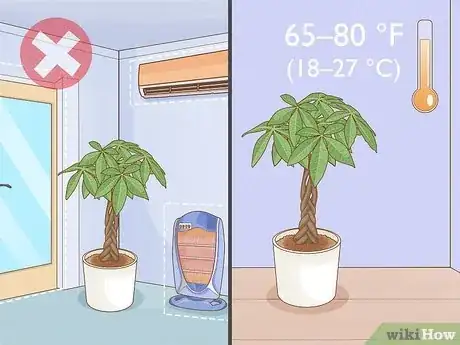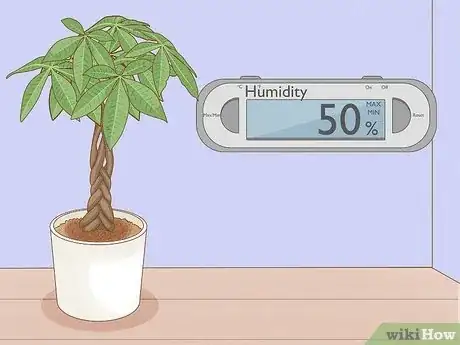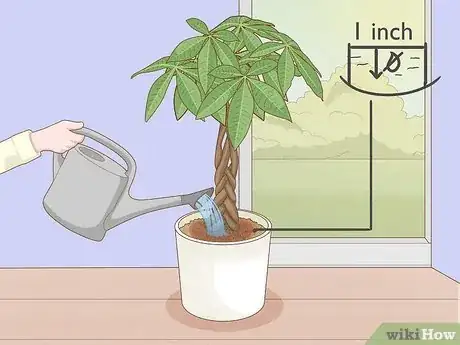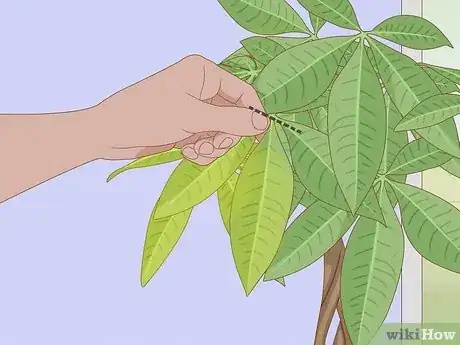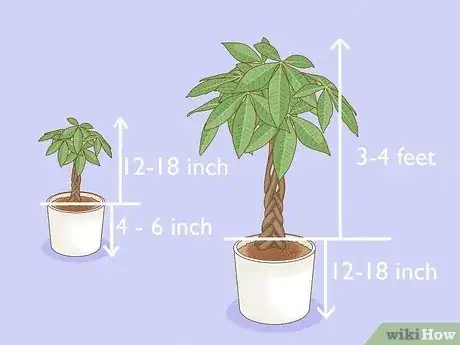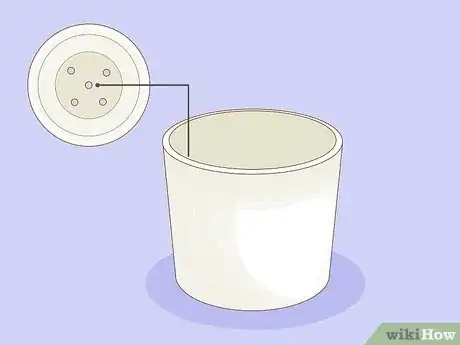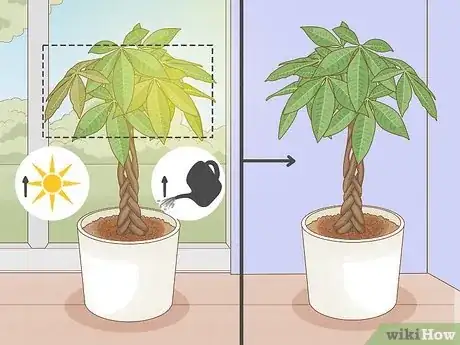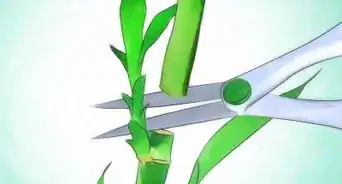This article was co-authored by Maggie Moran and by wikiHow staff writer, Eric McClure. Maggie Moran is a Professional Gardener in Pennsylvania.
There are 11 references cited in this article, which can be found at the bottom of the page.
wikiHow marks an article as reader-approved once it receives enough positive feedback. In this case, 93% of readers who voted found the article helpful, earning it our reader-approved status.
This article has been viewed 467,679 times.
Whether you’re a seasoned plant aficionado or a novice plant owner looking to spruce up their living space with some greenery, the money tree is an excellent houseplant. As both an omen of good luck and easy-to-care-for plant, it’s easy to see why so many people keep this lovely little tree around. In this article, we’ll break down everything you need to know about growing and caring for the lucky money tree. From general care to common diseases, we’ll cover it all!
Things You Should Know
- Place your money tree in an area where it will get bright, indirect light.
- Maintain a humid environment and keep your plant in an area where it’ll stay 65–80 °F (18–27 °C).
- Give your money tree more water whenever it dries out (roughly once every 1-2 weeks).
- Water your plant less often or move it to a shadier area if your money tree’s leaves start to turn yellow.
Steps
Light & Temperature
-
1Put your money tree somewhere it will get bright, indirect light. Pick a location where your money tree will get plenty of light without the sun shining right on it all day. Keep your money tree away from windows if they’re lit up with sunlight every day. Direct sunlight can scorch the leaves on your money tree.[1]
- You can tell that your money tree is getting too much light if the leaves start to turn yellow and dry out.
- A stand in your living room or the top of your dresser in your bedroom would be good spots for your money tree, so long as the plant won't receive a lot of direct sunlight.
- Try to rotate your tree 30- to 90-degrees every time you water it. This will distribute the sunlight evenly as it grows.
-
2Keep your money tree in an area that’ll stay 65–80 °F (18–27 °C). Money trees really don’t like extreme temperatures. Find a spot for your money tree that's not next to an air conditioning vent or radiator, and keep it in a room that won’t get crazy drafts. The lucky money tree will tolerate some minor fluctuations in temperature, but try to keep it stable.[2]Advertisement
-
3Choose a spot that’s consistently 50% humidity, if possible. Money trees need a lot of humidity to survive.[3] If you live in a dry climate and you're worried about the humidity levels being too low, set up a humidifier near your money tree. Get an indoor humidity monitor so you can keep track of how humid it is in the room your money tree is in if you want to monitor it closely.[4]
- Money trees have been known to tolerate humidity levels as low as 25-30%, although you may need to water them slightly more often and they may lose slightly more leaves than they otherwise would.
Water
-
1Add water to the soil when the top 1 in (2.5 cm) is dry. Your lucky money tree isn’t going to be super thirsty so long as there’s some humidity. Don't water your money tree when the soil is still damp or you could overwater it and cause root rot. To check if the soil is dry enough, gently touch the topsoil with your finger. If it’s bone dry, it’s time water your money tree.[5]
-
2Pour enough water until it begins to flow out of the drainage holes. Once you see water draining out of the holes at the bottom of your container, stop watering. Make sure you keep watering until you see the excess water come out or your money tree might not get as much water as it needs.[6]
- Overwatering a money tree is a lot easier to do than underwatering it. Money trees will do just fine if you’re a little light on the water, so try not to overdo it.
- Once you’re done watering, dump out any excess water in the tray under the pot. Your money tree won't be able to use any excess sitting water, and that extra moisture can cause root rot.
-
3Water your money tree a little less often during the winter. Money trees grow a lot slower during the winter because there's not as much light. Because they grow less, they don't need as much water. During the colder months, wait an extra 2-3 days after the soil dries out before you water it again. Start watering regularly again once springs arrives.[7]
- Even if it doesn’t get very dark out where you live during the winter, the money tree will appreciate a few months of lighter waterings.
Pruning & Shaping
-
1Pluck any yellow or dead leaves from the branch by hand. A yellowing or browning leaf will easily pop off of its branch, so just pinch the base of the leaf and remove it by hand. Keeping all of the money tree’s leaves green will ensure your plant doesn’t waste resources trying to keep dying leaves alive. When you notice a dead or damaged leaf, clip it off at the base of the branch.[8]
- It's OK if you don't trim off the dead or damaged leaves on your money tree. Your tree just may not look as healthy as it could if you did trim them off.
-
2Shape your money tree with pruning shears if you’d like. You do not have to shape the tree, but the money tree’s curling, magnificent trunks are so much fun to shape! To shape your money tree, look at the tree and imagine the outlines of the shape you want. Then, look for growth that's extending outside the boundary of the imaginary lines. Use pruning shears to clip off the excess growth outside the boundary line. When you're clipping off the growth, clip right after the leaf node that's nearest to the boundary line.[9]
- The node refers to the point where the main branch of a leaf meets the central stem.
- Money trees traditionally have a round, conical shape, but you can give yours a square or triangular shape instead if you'd prefer.
-
3Prune your tree during the spring to keep it small for a bonsai look. If you want your money tree to get bigger, avoid pruning it. If you’re going for that bonsai-style vibe, cut back excessive growth and the largest leaves on the plant in the spring with pruning shears. This will stunt the plant’s growth in the growing season and keep it from getting much bigger than it already is.[10]
- Leave at least half of the smallest leaves so that the plant can still absorb sunlight.
Soil & Fertilizer
-
1Plant your money tree in a pot big enough for the growth you want. Money trees are pot-bound, and they’ll basically grow as large as you let them. A 4 to 6 in (10 to 15 cm) pot is ideal for a 12–18 in (30–46 cm) tall money tree, which is perfect for an end table or mantle. If you want a massive money tree, use a larger pot! A 12–18 in (30–46 cm) pot will allow your money to tree to grow taller than 3–4 feet (0.91–1.22 m).[11]
- Money trees will grow as big as 10–12 feet (3.0–3.7 m) or as small as 8 inches (20 cm) depending on how big of a pot you give them. In their natural environment, money trees will grow up to 60 feet (18 m) tall!
-
2Ensure the pot has adequate drainage holes. Drainage holes allow excess water to drain out of the pot and into a tray beneath it. Money trees are prone to root rot, which is caused by too much water, so it's important your money tree has plenty of drainage. When you're shopping for pots, look down inside of them at the bottom of the pot. If there aren't any drainage holes, look for another pot.[12]
- You can tell root rot is setting in when the leaves uniformly turn yellow and wilt, and the base of the main branches are browned and softened at the base.
-
3Use any commercial fast-draining, nutrient-rich potting soil. Use a premade soil mix, or make your own potting mix using a peat-moss based potting soil. Any soil high in nitrogen, phosphorus, and potassium will work.[13]
- Money trees are pretty tolerant when it comes to the soil. Unless you pot the plant in clay, it should survive just fine.
- If you notice your money tree's roots growing out of the bottom of the pot, it's time to repot it.
-
4Fertilize your money tree 3-4 times a year. Money trees grow the most during the spring and summer, and seasonally fertilizing the plant will help keep your money tree healthy and growing strong. Use a water-soluble liquid fertilizer and scatter a few pea-sized dollops into the topsoil.[14]
- Any general liquid fertilizer will work so long as it isn’t designed specifically for outdoor plants.
- People have success using fertilizers with varying NPK ratios. There doesn’t seem to be a single “best” option for money trees.
Pests & Common Problems
-
1Raise the humidity levels around your money tree if it looks dry. Dry, falling leaves are a sign that your money tree isn't getting enough humidity. If you already use a humidifier, start leaving it on for longer amounts of time, or get a second humidifier. Make sure your money tree isn't near any heat vents that could be drying out the air.[15]
- Watering your money tree more won't help with the dryness, and it could make the problem worse by causing root rot or the leaves on the tree to turn yellow.
-
2Curb watering and move it out of the light if the leaves yellow. Unlike a lot of plants, money trees are very good at letting you know when they’re unhappy. If leaves start yellowing out, you’re either overwatering or giving it too much light. If the soil 2 inches (5.1 cm) below the topsoil is damp, stop watering so often. If the soil is dry, pull it back from the light.[16]
- Curbing the light exposure might involve just moving the money tree back 2–3 feet (0.61–0.91 m) from the nearest window.
-
3Apply neem oil to the money tree to kill pests. Money trees are not particularly common targets for pests, although spider mites and gnats occasionally nibble on a money tree.[17] If you spot pests, simply spray your money tree with neem oil (or any insecticidal soap) daily until the bugs are gone.[18]
- Money trees rarely have major issues with pests on their own. If your money tree appears to keep having issues with pests, it’s likely a sign that the bugs are coming from another plant in your home.
Expert Q&A
-
QuestionHow often do you water a money tree?
 Maggie MoranMaggie Moran is a Professional Gardener in Pennsylvania.
Maggie MoranMaggie Moran is a Professional Gardener in Pennsylvania.
Home & Garden Specialist It is best to allow the soil at the top to dry out before watering. You do not water the plant until the top 2-4 inches of soil are dry. Note that overwatering can cause root rot.
It is best to allow the soil at the top to dry out before watering. You do not water the plant until the top 2-4 inches of soil are dry. Note that overwatering can cause root rot. -
QuestionWhy are the leaves on my money tree falling off?
 Maggie MoranMaggie Moran is a Professional Gardener in Pennsylvania.
Maggie MoranMaggie Moran is a Professional Gardener in Pennsylvania.
Home & Garden Specialist The two reasons that this could be happening are overwatering or allowing too much sun.
The two reasons that this could be happening are overwatering or allowing too much sun. -
QuestionHow much sun does a money tree need?
 Maggie MoranMaggie Moran is a Professional Gardener in Pennsylvania.
Maggie MoranMaggie Moran is a Professional Gardener in Pennsylvania.
Home & Garden Specialist The money tree grows best in either full sun or partial shade. If they grow outdoors, they do not need direct sun, but indoor money trees do best in full sun.
The money tree grows best in either full sun or partial shade. If they grow outdoors, they do not need direct sun, but indoor money trees do best in full sun.
References
- ↑ https://sites.psu.edu/forloveofchlorophyll/2018/01/23/pachira-aquatica/
- ↑ https://www.houseplant411.com/houseplant/pachira-aquatica-how-to-grow-care-guide/
- ↑ http://www.guide-to-houseplants.com/money-tree-plant.html
- ↑ https://getbusygardening.com/money-plant-care/
- ↑ http://www.guide-to-houseplants.com/money-tree-plant.html
- ↑ https://getbusygardening.com/money-plant-care/
- ↑ http://www.guide-to-houseplants.com/money-tree-plant.html
- ↑ https://whyfarmit.com/yellow-money-tree-leaves/
- ↑ https://getbusygardening.com/money-plant-care/
- ↑ https://www.youtube.com/watch?v=PYIujR4HBEA&feature=youtu.be&t=34
- ↑ https://sites.psu.edu/forloveofchlorophyll/2018/01/23/pachira-aquatica/
- ↑ https://www.apartmenttherapy.com/indoor-tree-the-easiest-youll-159393
- ↑ https://sites.psu.edu/forloveofchlorophyll/2018/01/23/pachira-aquatica/
- ↑ https://www.apartmenttherapy.com/indoor-tree-the-easiest-youll-159393
- ↑ https://extension.uga.edu/publications/detail.html?number=B1318
- ↑ https://www.gardenerreport.com/how-to-save-a-money-tree-with-yellow-leaves/
- ↑ https://sites.psu.edu/forloveofchlorophyll/2018/01/23/pachira-aquatica/
- ↑ http://npic.orst.edu/factsheets/neemgen.html
- ↑ https://apps.cals.arizona.edu/arboretum/taxon.aspx?id=1222
About This Article
If you have a money tree, place it in a room that has at least 50% humidity and receives an abundance of indirect light. Water your money tree whenever the top 1 to 2 inches of soil are dry and empty the drainage tray underneath it so it's not sitting in water. Re-pot your money tree every 2-3 years, and place it in a pot that’s only slightly larger than it’s previous pot. For more tips on caring for your money tree, like how often you should add fertilizer and when to prune it, read on!

